|
|
 |
Fiche d'espèce de Copépode |
|
|
Calanoida ( Ordre ) |
|
|
|
Arietelloidea ( Superfamille ) |
|
|
|
Augaptilidae ( Famille ) |
|
|
|
Euaugaptilus ( Genre ) |
|
|
| |
Euaugaptilus laticeps (Sars, 1905) (F,M) | |
| | | | | | | Syn.: | Augaptilus laticeps Sars, 1905 c (p.11, Descr.F); Farran, 1908 b (p.72, Rem.); Lysholm & Nordgaard, 1921 (p.26);
no Augaptilus placitus A. Scott, 1909 (p.137, figs.F);
no Augaptilus antarcticus Wolfenden, 1911 (p.334);
no Augaptilus fungiferus : Wolfenden, 1911 (p.187);
no Euaugaptilus laticeps : Farran, 1929 (p.269); Vervoort, 1957 (p.139); Tanaka & Omori, 1967 (p.252) | | | | Ref.: | | | Sars, 1925 (p.264, figs.F,M); Farran, 1926 (p.289); Sewell, 1932 (p.321); Rose, 1933 a (p.223, figs.F,M); Jespersen, 1940 (p.59); Lysholm & al., 1945 (p.38); Sewell, 1947 (p.209); 1948 (p.504); Tanaka, 1964 b (p.50, figs.F); Vervoort, 1965 (p.136, Rem.); Owre & Foyo, 1967 (p.86, figs.F,M); Matthews, 1972 (p.23, 33: Rem., 60); Tanaka & Omori, 1974 (p.226, figs.M); Roe, 1984 (p.358); Boxshall, 1985 (p.306, Rem.); Park, 1993 (p.30, figs.F, Rem.); Razouls, 1994 (p.170, figs.F,M); Bradford-Grieve & al., 1999 (p.882, 939, figs.F,M); Bradford-Grieve,1999 b (p.54, figs.F,M, Rem., figs.171, 190); Matsuura & Nishida, 2000 (p.339); Vives & Shmeleva, 2007 (p.201, figs.F,M, Rem.) |  issued from : O. Tanaka in Publs Seto Mar. Biol. Lab., 1964, XII (1). [p.50, Fig.197]. Female: a, habitus (dorsal); b, forehead (lateral left side); c, last thoracic segment and urosome (left lateral side); d, masticatory edge of Md; e, Mx1; f, P1; g, P5.
|
 issued from : J.M. Bradford-Grieve in The Marine Fauna of New Zealand: Pelagic Calanoid Copepoda. National Institute of Water and Atmospheric Research (NIWA). NIWA Biodiversity Memoir, 111, 1999. [p.54, Fig.26]. Female: A, habitus (lateral left side); B, idem (dorsal); C, Md (mandibular palp); D, Mx1; E, P1; F, P5.
|
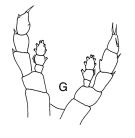 issued from : J.M. Bradford-Grieve in The Marine Fauna of New Zealand: Pelagic Calanoid Copepoda. National Institute of Water and Atmospheric Research (NIWA). NIWA Biodiversity Memoir, 111, 1999. [p.54, Fig.26]. Male (redrawn from Sars, 1924): G, P5.
|
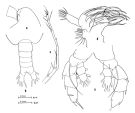 issued from : O. Tanaka & M. Omori in Publs Seto Mar. Biol. Lab., 1974, XXI (3/4). [p.227, Fig.15. Male: a, forehead (lateral); b, last thoracic segment and urosome (dorsal); c, distal part of A1; ; d, Mx1; e, P5.
|
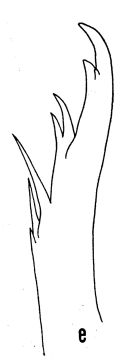 issued from : O. Tanaka & M. Omori in Publs Seto Mar. Biol. Lab., 1974, XXI (3/4). [p.199, Fig.2,e]. Female: e, mandibular teeth.
|
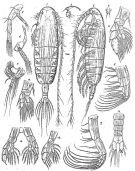 Issued from : G.O. Sars in Résult. Camp. Scient. Prince Albert I, 69, pls.1-127 (1924). [Pl.LXXX, figs.1-14]. Female: 1, habitus (dorsal); 2, idem (lateral left side); 3, forehead (lateral); 4, rostrum; 5, A2; 6, Md; 7, Mx1; 8, Mx2; 9, Mxp; 10, P1; 11, P3; 12, P5. Male: 13, P5; 14, urosome (dorsal).
|
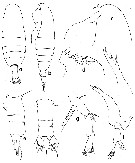 issued from : T. Park in Biology of the Antarctic Seas, XXII. Antarct. Res. Ser., Washington, 58. [p.30, Fig.21]. Female: a-b, habitus (dorsal and lateral, respectively); c-d, forehead (lateral and ventral, respectively); e-f, urosome (lateral and dorsal, respectively); g, A2; h, Md; i, Md (biting edge). Nota: Rostrum consisting of 2 filaments of medium size. Urosome about 26 % length of prosome. Genital segment (dorsally) about 1.1 times as long as wide and about 41 % length of urosome. Measured along lateral side, 3rd urosomal segment about 1.6 times length of 2nd, and about 86 % length of caudal ramus.
|
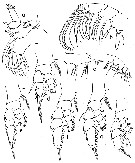 issued from : T. Park in Biology of the Antarctic Seas, XXII. Antarct. Res. Ser., Washington, 58. [p.31, Fig.22]. Female: a, Mx1; b, Mx2; c, Mxp; d-h, P1 to P5 (anterior views).
|
 issued from : H. Matsuura & S. Nishida in Mar. Biol., 2000, 137. [p.341, Fig.2, A-B]. Female (from eastern Indian and NW Pacific): SEM micrographs of button setae on Mx2 and Mxp: A, subterminal part of a seta; B, transitional part of a seta. Nota: The discs are semicircular with more or less linear margins on the distal side of a seta. In the button setae the basal-most setules are replaced distally by triangular spines which form two rows on the middle part and change into buttons, arranged side-by-side, more distally. The diameter of the discs is ca. 0.006 mm throuhout the seta, except on the terminal part, where decreases to about half of that of the discs on the more basal part. Number of button setae on Mx2: 0 on basis, 7 on endopod; on Mxp: 7 on endopod.
|
 issued from : H.B. Owre & M. Foyo in Fauna Caribaea, 1, Crustacea, 1: Copepoda. Copepods of the Florida Current. 1967. [p.86, Figs.578, 579]. Female: 578, P1; 579, P5.
|
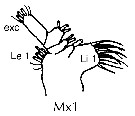 issued from : J.M. Bradford-Grieve, E.L. Markhaseva & C.E.F. Rocha & B. Abiahy in South Atlantic Zooplankton, Edit. D. Boltovskoy. 1999. Vol.2. Copepoda. [p.1038, Fig. 7.252]. Female: Mx1. Nota: Exopod of Mx1 with 6 setae; outer lobe with 7 setae.
|
 issued from : J.B.L. Matthews in Bull. Br. Mus. (Nat. Hist.) Zool., 1972, 24 (1). [p.24, Fig.10]. Left and right gnathobase of a doubtful specimen of Euaugaptilus laticeps (loan from the Bergen Museum). Originally identified as RE. nodifrons, probably on account of the absence of rostral filaments, was found to fit the description of E. laticeps in all other respects; the rostral protuberance was distinctly bifid and well developed (it is possible that the filaments had been broken off). Because of doubt over its identity it is included here only in the consideration of mandibular structure, in which it showed some astmmetry. The specimen possesses a typical laticeps gnathobase on one mandible but to have one tooth fewer on the other. Specimens show the teeth on the gnathobase without variation but there were 5 setae on the exopodite of one specimen and 4 on the other. Sars (1925) figured 5 setae, while Sewell (1947) recorded 4.
|
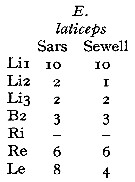 issued from : J.B.L. Matthews in Bull. Br. Mus. (Nat. Hist.) Zool., 1972, 24 (1). [p.25, Table 2]. Differences in setation of Mx1, according to previous descriptions.
|
 issued from : J.B.L. Matthews in Bull Gr. Mus. (Nat. Hist.) Zool., 1972, 24 (1). [p.25, Table I). Occurrence of a seta on the posterior surface near the outer margin of basipodite of P1, P4 and P5. Numbers refer to the number of individuals examined. In the material sxamined by Matthews (1972, p.24) Mx1 from one of the two specimens had 11 setae on the 1st endite and 2 on the 2nd, while these appendages in the other specimen had 10 and 1 respectively. The first specimen also possessed some additional small setae on the exopodite and exite
|
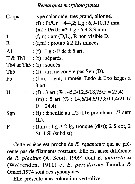 Issued from : C. Razouls in Ann. Inst. océanogr., Paris, 1994, 70 (1). [p.170]. Caractéristiques morphologiques de Euaugaptilus laticeps femelle et mâle adultes. Terminologie et abbréviations: voir à Calanus propinquus.
| | | | | Ref. compl.: | | | Sewell, 1948 (p.330, 504, 508, 525, 530, 533, 547, 549); C.B. Wilson, 1950 (p.205); Grice, 1963 a (p.496); De Decker & Mombeck, 1964 (p.12); Grice & Hulsemann, 1967 (p.18); Itoh, 1970 (tab.1); Roe, 1972 (p.277, tabl.1, tabl.2); Björnberg, 1973 (p.348, 385); Deevey & Brooks, 1977 (p.156, tab.2, Station "S"); Vives, 1982 (p.294); Kovalev & Shmeleva, 1982 (p.85); Guangshan & Honglin, 1984 (p.118, tab.); Hopkins & Torres, 1988 (tab.1); Lozano Soldevilla & al., 1988 (p.60); Suarez & Gasca, 1991 (tab.2); Suarez, 1992 (App.1); Donnelly & al., 1994 (p.171, chemical composition); Shih & Young,1995 (p.68); Suarez-Morales & Gasca, 1998 a (p108); Voronina & Kolosova, 1999 (p.71); Lapernat, 2000 (tabl.3, 4); Razouls & al., 2000 (p.343, tab. 5, Appendix); Holmes, 2001 (p.12); Galbraith, 2009 (pers. comm.); Park & Ferrari, 2009 (p.143, Table 5, Appendix 1, biogeography); Matsuura & al., 2010 (p.2098, Table 2, 3, fig.8) | | | | NZ: | 17 | | |
|
Carte de distribution de Euaugaptilus laticeps par zones géographiques
|
| | | | | | | | | | | | | | | | Loc: | | | Antarct. (Peninsula, Weddell Sea, SW & S Atlant., SW & SE Pacif.), sub-Antarct. (Indian), South Africa (E), Atlant. (tropical, temperate), Ghana, off NW Cape Verde Is., Canary-Azores, off Madeira, G. of Mexico, Florida, off Bermuda (Station "S"), Sargasso Sea, S Iceland, off W Ireland, Bay of Biscay, off W Cabo Finisterre, Iboro-morocan Bay, W Medit., Indian, Laccadive Is., Celebes and Sulu Seas, Philippines, China Seas (East China Sea), Philippines, Japan (Izu region), Vancouver Is., SW Galapagos, N Easter Is., off Peru, Chile, Pacif. (W equatorial), New Zealand (SW, NW & N North Island) | | | | N: | 26 | | | | Lg.: | | | (1) F: 7,6; (16) F: 7,2-6,9; M: 6,8-6,3; (38) F: 7,68; (48) F: 7,91-7,5; (68) F: 7,4-7,1; M: 7,3-6,8; (69) F: 7,43; (199) F: 8-6,6; (909) F: 7,4; 7,6; (1066) F: 7,0-7,1; {F: 6,30-8,00; M: 6,30-7,30} | | | | Rem.: | méso-bathypélagique.
Park (1993) considère que E. antarcticus n'est pas synonyme de E. laticeps , contrairement à l'opinion de Farran (1929) et Matthews (1972).
Pour Boxshall cette espèce n'est pas synonyme de E. placitus comme l'estiment Sewell, Matthews et Bradford-Grieve (1999 b, p.47).
Voir aussi les remarques en anglais | | | Dernière mise à jour : 04/12/2020 | |
|
|
 Toute utilisation de ce site pour une publication sera mentionnée avec la référence suivante : Toute utilisation de ce site pour une publication sera mentionnée avec la référence suivante :
Razouls C., Desreumaux N., Kouwenberg J. et de Bovée F., 2005-2025. - Biodiversité des Copépodes planctoniques marins (morphologie, répartition géographique et données biologiques). Sorbonne Université, CNRS. Disponible sur http://copepodes.obs-banyuls.fr [Accédé le 28 novembre 2025] © copyright 2005-2025 Sorbonne Université, CNRS
|
|
 |
 |















